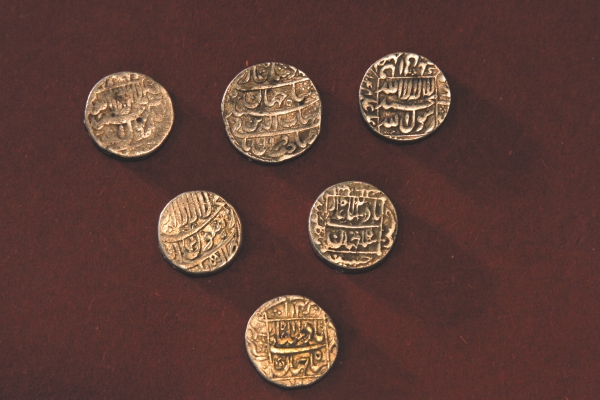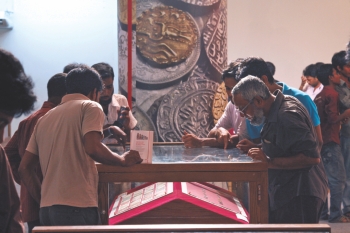| Home - Back Issues - The Team - Contact Us |
 |
| Volume 11 |Issue 29| July 20, 2012 | |
|
|
Heritage
MONEY TALKS Sarara Hasan
Observing the intricate pieces of metal, with its detailed tiny mints of history imprinted on it, can be quite intriguing. The history of coins is a little murky, because so many coins have been found across the globe from so many different ages. A coin can be defined as a metallic piece used as a medium of exchange and having a specific metallic weight standard and a certain metallic purity. Coins have held the attention of major civilisations of the world and have been traded for goods and services throughout the world through time. Coins were mainly hand-struck with a hammer and an anvil. The punch method made it practical and feasible to produce larger quantities of coins, and the practice quickly spread throughout the civilized world. Because of the lasting power of the metals used to make coins, many very old and rare coins still exist today. And more ancient and not-so-ancient coins are constantly being uncovered thanks to formal digs and chance discoveries by archeologists. For the collectors of historic coins, these are exciting times. Coins have played a major role throughout centuries in reflecting and telling stories of the evolving civilisation and history of Bengal. To commemorate the ever changing history of coins and currency notes of Bengal, Bangladesh National Museum along with HSBC and Bangladesh Bank have come together and organised 'Abohoman Banglar Mudra O Kagoji Note Prodorshoni'. The special exhibition that is open to all, was inaugurated on July 9, 2012 and will continue until July 20, 2012. The exhibition is taking place in the 'Nolinikanto Bhottoshali Prodorshoni Gallery' of the museum. Since its opening it has been hard to keep the crowds out. Beautiful pieces of metal dating back from centuries before our time have been displayed in the exhibition. Coins from the present period of Bangladesh to the Pakistani periods, the period from the British rule, the Moghul eras, the Sultani eras and even the coins from the ancient Pal-Sen-Gupto eras are showcased in the exhibition. It is very exciting to see with your very own eyes the coins that used to be used from such a long time and that has been passed on and preserved until today. Some of the types of objects, which are displayed in the exhibition, used as coins were not always made of metal. For example, during the Pala-Sena era, no metal coins were used and instead, Cauri-shells or 'Kakanika' (shells of dead sea-creatures) were used as a medium of exchange in Bengal up until 18th century AD These Cauri-shells were found in Magura in a jar by some archeologists.
Even though all the different coins in the exhibition are one of a kind, there are some particular coins which may catch the eyes of most of the visitors. The tiny gold coin, for instance, known as 'Fanam' coin of South India, bears the name of the Mughal Emperor Aurangajeb Alamgir. The miniscule gold coin is smaller than the size of a fingernail and only weighs 0.18 grams! A gold coin from 1334 A.D. is also present which represented the first sultan of Bengal, who had declared independence from Sonargaon and it weighs 10.94 grams. Silver punch marked coins from the Imperial series can also be found here. Dating back from the 3rd century BC to 2nd century AD, such coins have been discovered from the excavation of Mahasthangar, Bogra. In the obverse side of the coin, a group of five symbols is depicted which indicate that they are coins of the Mauryan Emperors, represented by hills, flowers, trees etc. Some of the punch marked silver coins are even from the 4th century B.C. or even the 5th century B.C. Not only can the coins from historic periods of time be found here, currency notes from the British-Indian rule periods are also showcased. In the absence of contemporary written sources for the history of Bengal, Sultani coins play a great role to fill up the gaps. And through the information supplied by the coins, some of the Bengal Sultans have come to light. From the name of the mints and date on the Muslim coins, one can ascertain the expansion of the kingdom, the reign period of the Sultans and their chronology. By analysing the Sultani coins, people may get the important information about the economic and cultural history as well as the political history of certain periods of Bengal. It can be easily noticed that the coins showcased in the exhibition had been carefully selected. It is really great and useful for people to visit this special exhibition and for them to gain knowledge and learn about the different coins exposed there. To learn the stories, to take in the art and to observe the detailed crafting of each coin, it is a great way to learn a bit of our Bengali history and culture. Copyright
(R) thedailystar.net 2012 |


